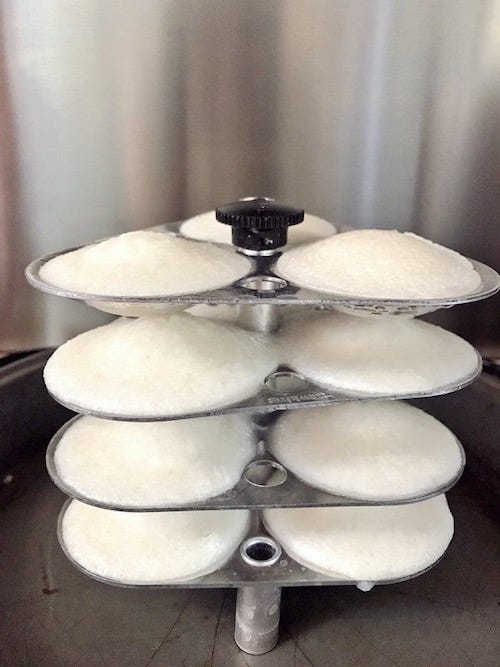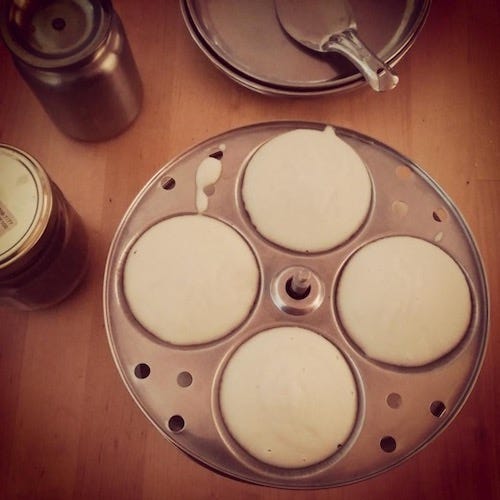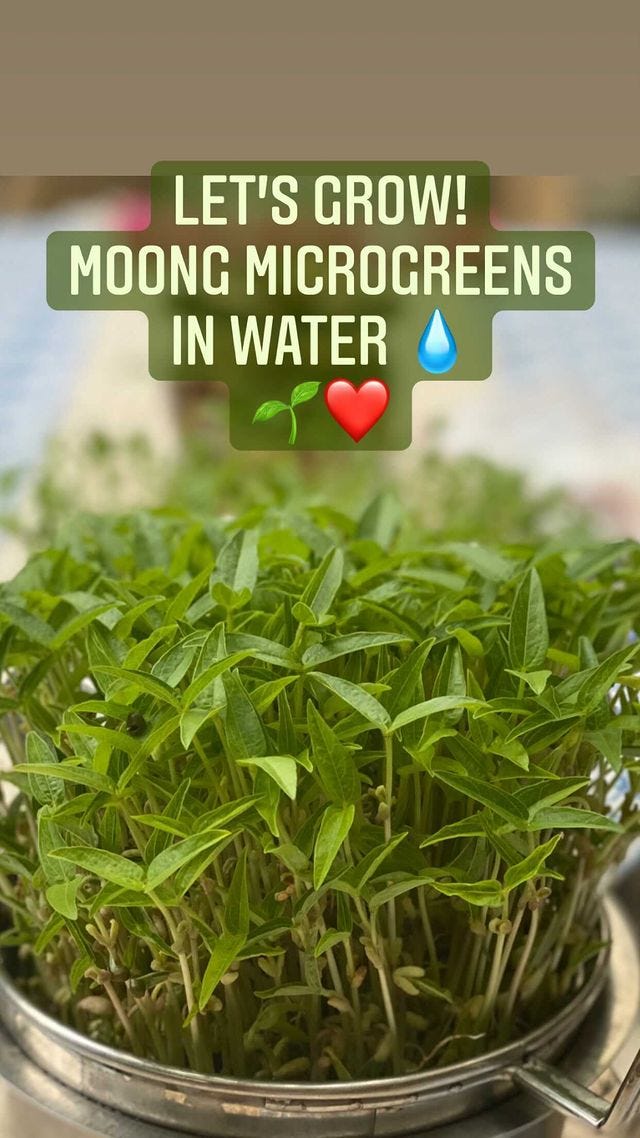Sattva: Issue 24
Solar recharge yourself | 10 tips for super soft idlis | Growing microgreens in the kitchen
Hello! If you are new to my newsletter, a warm welcome.
Sattva (सत्त्व) is a beautiful Sanskrit word that has many meanings—spirit, true essence, good sense, wisdom, quality of purity, energy, consciousness and mind, among other things.
Through this fortnightly newsletter, I want to bring to you all things good, which will make your life better. My focus will be on topics such as mindfulness, productivity, slow living and sustainability, accompanied by genuinely useful recommendations of products, books, music, links to read, and of course food and recipes. Through these, I hope to instil some Sattva in your life.
Solar recharge yourself
In a day, how many hours do you spend outdoors? How much time do you spend in the sun? I recently came across this article in FT titled ‘Why I switched to solar time’ on how people are taking a break from their urban lives to live in eco-cabins in the middle of nature to spend their days guided only by the sun.
Given how humans have always lived in sync with nature - the sun, the moon, the seasons and the nature surrounding us, this phase of being completely disconnected from nature is a mere speck in the entire history of humanity. Humans are not meant to be in closed spaces all day. The FT article quotes ultra-endurance athlete Tony Riddle, “we have normalised spending a whopping 21.76 hours of our day inside. Yet when it comes to our wellbeing, sunlight is no different to movement, food and quality sleep.”
Two years of the pandemic have worsened the numbers. People with desk jobs rarely get to be outdoors in the daytime on weekdays. In the case of homemakers in cities, the house chores keep them busy during the day and any free time goes towards some much-needed rest and recuperation. Also, for women, the lack of free and open safe spaces like parks to walk around without feeling threatened keeps us indoors. In most cities, the only place that a family can go to on the weekends is a mall.
One of the main reasons to be out in the sun every day, if possible, is vitamin D. Our body synthesizes vitamin D on exposure to sunlight, and being closeted indoors leads to this deficiency even among Indians, despite having an abundance of sunlight all year round. Lack of adequate sun exposure also manifests as a depressed and moody feeling, aches in the bones, weight gain and bad sleep rhythm among other physical and mental effects.
On some days with writing deadlines and a general dull mood, I do not step out of the house all day, without realising that the dull mood may well be because I did not expose myself to solar power. I am sure you have experienced this too.
Being out in natural light is also important for our circadian rhythm.
Circadian rhythms are physical, mental, and behavioural changes that follow a 24-hour cycle. These natural processes respond primarily to light and dark and affect most living things, including animals, plants, and microbes.
We underestimate the power of circadian rhythms. Humans, the so-called most intelligent species on planet earth and are the only ones who spend our lives defying nature’s rhythms. One of the best ways to align our schedules to our body's circadian is to wake up with the sun and step out, even if it is just for 10 minutes. I wrote about it in my issue on walking. If you are unable to step out, open all the curtains and let the natural light inside. Our brain reacts to the light streaming in by cutting off the melatonin secretion (melatonin signals to the brain that it’s night time and time to sleep) and vice versa when it is dark.
I hope this inspires you to spend more time outdoors. We don’t have to rent eco-cabins in the woods for hundreds or thousands of pounds a week to restart our relationship with the sun. Do some research on natural spaces, parks and lesser-known places in and around the city where you live, and spend your free days being out and about. If you know of any such places around your city, do share it in the comments. Let us solar recharge ourselves!
Super soft idlis, every time! #WorldIdliDay
Early this morning, my kitchen was buzzing. I was steaming idlis, toasting dals for molagapodi and preparing a curry leaf tadka for coconut chutney. I was feeling the stress of multitasking when my son walked into the kitchen to fill his water bottle for school. He stopped for a moment and said, "this smells like India." His words made me pause and savour the meaning of what he said so instinctively.
Turns out, today is World Idli Day. For a long time, I was scared of making idlis from scratch because I don’t have a wet grinder. I could be the only south Indian food blogger without a wet grinder in her kitchen! The wet grinder makes the urad dal so much more fluffy and aerated which is essential to get soft, mallipoo-like (mallippoo =mogra in Tamil) idlis. You also need a lesser quantity of urad dal to make the batter when you use a wet grinder.
In its absence, here are some tips (none of which include ENO), to get soft idlis using your regular mixer. Do note that the mixer should be around 750 watts which allows you to grind these batters without the motor burning out.
10 tips for soft idlis in the mixer-grinder
Use a minimum of 1:3 ratio of urad dal and idli rice. Use the whole round urad dal (skinned). A better quality of dal allows you to go up to 1:4 ratio i.e. one part urad dal for 4 parts of idli rice.
The addition of a small quantity of poha along with the dal helps get softer idlis even if you grind the batter in the mixer.
Soak the rice for 4-6 hours or even overnight if that is convenient for you.
Do not soak the urad dal overnight as longer soaking prevents the dal from aerating to its full capacity. I have seen this from personal experience. Soak the urad dal along with the methi seeds and poha for just one hour.
Urad dal soaks in a lot more water while grinding the batter. Rice does not soak as much water. Urad dal needs to be ground to a very soft fluffy consistency while the rice batter can be kept a little coarse. It is therefore important to grind the two batters separately and then mix them together.
The mixer heats up the contents when it is kept running for longer. Use iced water to add to the contents of the mixer while grinding the batter. When the batter gets heated while grinding, a lot of bacteria and wild yeast in the urad dal, methi seeds and idli rice will get killed, not leaving enough population for proper fermentation of the batter. This will lead to harder idlis without the much loved mildly tangy flavour.
Don’t load the mixer with the entire batch of rice or dal. Grinding in smaller batches allows the space for better aeration of the batter. A larger batch will also take longer to grind thereby heating up the mixer.
The mixing of the two batters is a very important stage for optimum fermentation. Take the required quantity of rock salt in your hand and mix the batter well with your hands. The bacteria on the surface of our skin (even clean washed hands) get into the batter, aiding fermentation.
After 8-10 hours of fermentation (faster in hot weather), the batter should have risen well, with plenty of air bubbles inside when you take some out with a ladle. Never beat the batter vigorously before making idlis. Stir gently and ladle the batter into oiled idli moulds.
Always save some of the fermented batter in your fridge to add to the next batch for faster fermentation.
Try this: My recipe for omega-3 rich flaxseed molagapodi
Microgreens in a sieve
The best thing about Instagram for me is that you get to learn little things from each other. There’s always an inspiration waiting in your feed. I grow crunchy bean sprouts using Maangchi’s method but never thought of extending that to growing microgreens. Neha Pol’s post on Instagram was just the perfect inspiration to start doing it.
This is the most fulfilling gardening activity you can do in just SIX DAYS!
What you need
Whole green moong
A sieve with slightly larger holes
A cover for the sieve
A vessel that the sieve fits on
Day 0: Soak whole green moong in a bowl of water.
Day 1: Drain moong and spread it out on a sieve. Place the sieve in a bowl and cover the sieve with a plate. This is to make the moong sprout.
You can wash the moong once during the day if the weather is very hot.
Day 2/3: By now, the moong would have sprouted. Continue same as day 1 - wash the sprouts in the sieve by showing them under running water. This is to prevent them from turning slimy/smelling bad/clumping and catching fungus.
Day 4: Once the sprouts have turned longer into tiny roots, fill the bottom bowl with drinking water such that the roots at the bottom of the sieve just touch the surface of the water. Keep the sieve covered on the top.
Day 5: By now, you will see green shoots come at the top and the roots have grown longer. Change the water in the bowl below. Uncover the sieve. Keep this whole set up on a window sill or in the open air in a balcony but not in direct sun.
Day 6: From day 5 to day 6, you will see a big growth in dark green tiny leaves, longer roots and it is time to harvest. Tug the stems lightly to remove them from the sieve. Air dry on a plate. Trim off the ends of the roots (this could be more fibrous), save them in a paper-lined box and refrigerate. Use in 2-3 days.
I did the same with matki (moth beans). They took two days longer to harvest, so that’s 8 days to harvest. My methi greens are already on day 6/7 and it is a joy to watch them grow on the patio table.
How I use these microgreens
Delicate microgreens are best used as a garnish on toast or salads or just to make any plate Insta-pretty.
Slightly larger microgreens can be tossed as a part of a salad.
Much larger microgreens like moong and matki can be used in theplas or as a stuffing in paratha or omelettes. I made a garden uthappam using the moong microgreens and I was surprised at how pretty it turned out.
If nothing, you can always blend it into a smoothie to get all its health benefits.
Resources:
Circadian rhythm definition
Solar repowering in FT
Neha Pol’s microgreens video on Instagram
Read my column on microgreens in Mint Lounge
I would love your feedback on my newsletter. If you like what you read, please share it with your family and friends. I am grateful for your help in reaching my newsletter to a wider audience.
Books: Everyday Superfoods | The Everyday Healthy Vegetarian
Blog | Amazon store | Twitter | Instagram
This newsletter may contain affiliate links for some products. As an Amazon affiliate, I may earn a small commission if you purchase something by clicking on my link, at no extra cost to you. It helps support the newsletter.
None of the product mentions are sponsored unless explicitly mentioned.









